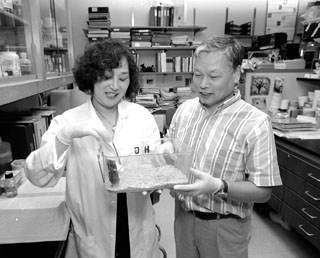The University Record, August 16, 1999 By Sally Pobojewski
News and Information Services

U-M scientists have identified two segments of DNA that work together to produce a steady increase in the capacity of blood to coagulate as we age—a discovery that could lead to new pharmaceutical drugs for blood clots, strokes and cardiovascular disease.
The two genetic elements are located in and near the gene for Factor IX—a key enzyme in the biochemical chain reaction that produces blood clots.
The discovery is significant because it is the first identification of the molecular basis for age-related changes in Factor IX and blood coagulation. It explains why coagulation capacity is almost twice as high in older people and other mammals as it is in young adults.
A paper describing these genetic elements and how they were identified in a long-term study of transgenic mice was published in the July 30 issue of Science. Authors of the paper are Sumiko Kurachi, U-M senior research associate; Yoshihiro Deyashiki, former U-M post-doctoral research fellow; Junko Takeshita, a former undergraduate summer research student from Wellesley College; and Kotoku Kurachi, U-M professor of human genetics.
“This is the first study to monitor age-related changes across the natural life span of a species and through several generations of descendants,” Kotoku Kurachi says. “Others have studied either very young or very old animals, but a longitudinal study is the only way to be sure that age-related changes are real, reproducible and independent of individual variations.”
When mammals are born, the coagulation capacity of their blood is only 40 percent to 45 percent of a young adult’s, Kurachi explains. After birth, clotting ability increases rapidly. By weaning age, coagulation capacity reaches young adult levels and continues to increase gradually during adulthood. By old age, levels are nearly twice as high as those of a young adult.
“This age-related increase in coagulation potential coincides with increases in pro-coagulant proteins like Factor IX in blood plasma,” Kurachi says. “But plasma levels of other factors which inhibit blood’s ability to clot do not increase significantly with age.”
To find out which parts of the large Factor IX gene control the age-related increase in Factor IX activity, U-M scientists divided the human gene into smaller segments and then recombined them to create more than 11 different minigenes. Each minigene contained active transcription areas of the natural gene’s DNA plus adjacent regions.
The scientists then used genetic engineering technology to insert these human minigenes into fertilized mouse eggs to create transgenic mice that produced human Factor IX, in addition to the mouse version. After the mice were born, Kurachi and his colleagues selected three-to-six founder mice for each human Factor IX minigene to be tested.
The researchers then monitored human Factor IX levels and coagulation capacity in the founder mice until they died at the end of their natural life spans, as much as two years later. Researchers also monitored, from birth-to-death, two to four generations of mice descended from each founder mouse. After analyzing all the data, Kurachi concluded:
“The AE5′ element appears to control stable expression of Factor IX, so coagulation can continue throughout the animal’s lifetime,” Kurachi says. “AE3′ promotes increased amounts of Factor IX as the animal ages by keeping levels of messenger RNA high, so the gene can pump out more Factor IX protein. Both elements work together to regulate the normal pattern of increased Factor IX gene expression with age.”
Kurachi stresses that the discovery of the key roles played by these two genetic elements is just the first of many questions still to be answered. In future research, he hopes to find out whether similar mechanisms involving AE3′ and AE5′ also regulate prothrombin, Factor X, Factor VII and other proteins required for normal blood coagulation. He also hopes to learn why increased coagulation is associated with a healthy old age in some people, but leads to blood clots, strokes and cardiovascular disease in others.
“Once we completely understand this very complex system, we should be able to design new pharmaceutical drugs to modulate increases in coagulation activity as we age,” Kurachi says.
The U-M has applied for patents on the gene elements found in Kurachi’s study. The research was supported by the National Institutes of Health; the Nathan Shock Center for the Basic Biology of Aging, the Pepper Center for Aging Research, the Multipurpose Arthritis and Musculoskeletal Disease Center, all at the U-M; and the Health System’s General Clinical Research Center.

